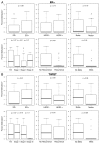Methylated genes in breast cancer: associations with clinical and histopathological features in a familial breast cancer cohort
- PMID: 21383541
- PMCID: PMC3116929
- DOI: 10.4161/cbt.11.10.15177
Methylated genes in breast cancer: associations with clinical and histopathological features in a familial breast cancer cohort
Abstract
Background: Hundreds of hypermethylated genes have been described in breast cancer, yet the nature and contribution of these genes in their methylated state to overall risk and prognosis is under-characterized in non-sporadic breast cancers. We therefore compared associations of DNA methylation with tumor stage, hormone/growth receptor status, and clinical outcomes in a familial breast cancer cohort. Because few previous methylation studies have considered the oncogenic or tumor suppressor properties of their gene sets, this functional status was included as part of our correlative analysis.
Results: We found methylation of oncogenes was associated with better prognostic indicators, whereas tumor suppressor gene methylation was associated with a more severe phenotype in women that were either HER2+ or lymph node positive at diagnosis, and/or tended to recur or develop distant metastases. For example, the methylation of the tumor suppressor gene APC was strongly associated with a specific subset of tumors that were both ER+ and HER2+, while methylation of the TWIST oncogene was associated with breast cancers that did not metastasize.
Methods: This was a retrospective, hospital-based study of n = 99 archival breast tumors derived from women with a germline genetic BRCA1 or BRCA2 mutation and/or familial breast cancer history. DNA methylation was quantified from formalin fixed, paraffin embedded tumors using the established protocol of quantitative multiplex-methylation specific PCR (QM-MSP). Non-parametric statistics were used to analyze candidate gene methylation in association with clinical outcomes.
Conclusion: We report several novel, positive associations between percent methylation of the APC, RASSF1A, TWIST, ERα, CDH1, and Cyclin D2 genes and key variables such as tumor stage, hormone and growth receptor status, and a history of recurrent or metastatic disease. Our data suggest the potential utility of parsing gene methylation by functional status and breast tumor subtype.
Figures





Comment in
-
Using methylation analysis to assess tumor heterogeneity in familial breast cancer.Cancer Biol Ther. 2011 Jun 15;11(12):1065-6. doi: 10.4161/cbt.11.12.15820. Epub 2011 Jun 15. Cancer Biol Ther. 2011. PMID: 21577053 No abstract available.
Similar articles
-
Estrogen receptor and HER2/neu status affect epigenetic differences of tumor-related genes in primary breast tumors.Breast Cancer Res. 2008;10(3):R46. doi: 10.1186/bcr2098. Epub 2008 May 16. Breast Cancer Res. 2008. PMID: 18485221 Free PMC article.
-
BRCA2 carriers with male breast cancer show elevated tumour methylation.BMC Cancer. 2017 Sep 11;17(1):641. doi: 10.1186/s12885-017-3632-7. BMC Cancer. 2017. PMID: 28893223 Free PMC article.
-
Methylation is less abundant in BRCA1-associated compared with sporadic breast cancer.Ann Oncol. 2008 Nov;19(11):1870-4. doi: 10.1093/annonc/mdn409. Epub 2008 Jul 22. Ann Oncol. 2008. PMID: 18647968 Free PMC article.
-
Clinicopathological significance and potential drug target of CDH1 in breast cancer: a meta-analysis and literature review.Drug Des Devel Ther. 2015 Sep 18;9:5277-85. doi: 10.2147/DDDT.S86929. eCollection 2015. Drug Des Devel Ther. 2015. PMID: 26425077 Free PMC article. Review.
-
Methylation signatures as biomarkers for non-invasive early detection of breast cancer: A systematic review of the literature.Cancer Genet. 2024 Apr;282-283:1-8. doi: 10.1016/j.cancergen.2023.12.003. Epub 2023 Dec 12. Cancer Genet. 2024. PMID: 38134587
Cited by
-
Quantitation of CDH1 promoter methylation in formalin-fixed paraffin-embedded tissues of breast cancer patients using differential high resolution melting analysis.Adv Biomed Res. 2016 May 30;5:91. doi: 10.4103/2277-9175.183139. eCollection 2016. Adv Biomed Res. 2016. PMID: 27308263 Free PMC article.
-
Tumor and serum DNA methylation in women receiving preoperative chemotherapy with or without vorinostat in TBCRC008.Breast Cancer Res Treat. 2018 Jan;167(1):107-116. doi: 10.1007/s10549-017-4503-2. Epub 2017 Sep 16. Breast Cancer Res Treat. 2018. PMID: 28918548 Free PMC article. Clinical Trial.
-
Promoter Hypermethylation in White Blood Cell DNA and Breast Cancer Risk.J Cancer. 2015 Jul 15;6(9):819-24. doi: 10.7150/jca.12174. eCollection 2015. J Cancer. 2015. PMID: 26284132 Free PMC article.
-
DNA Methylation Markers for Breast Cancer Detection in the Developing World.Clin Cancer Res. 2019 Nov 1;25(21):6357-6367. doi: 10.1158/1078-0432.CCR-18-3277. Epub 2019 Jul 12. Clin Cancer Res. 2019. PMID: 31300453 Free PMC article.
-
Validation of DNA promoter hypermethylation biomarkers in breast cancer--a short report.Cell Oncol (Dordr). 2014 Aug;37(4):297-303. doi: 10.1007/s13402-014-0189-1. Epub 2014 Aug 16. Cell Oncol (Dordr). 2014. PMID: 25123395
References
-
- Jin W, Chen L, Chen Y, Xu SG, Di GH, Yin WJ, et al. UHRF1 is associated with epigenetic silencing of BRCA1 in sporadic breast cancer. Breast Cancer Res Treat. 2010;123:359–373. - PubMed
-
- Fackler MJ, Malone K, Zhang Z, Schilling E, Garrett-Mayer E, Swift-Scanlan T, et al. Quantitative multiplex methylation-specific PCR analysis doubles detection of tumor cells in breast ductal fluid. Clin Cancer Res. 2006;12:3306–3310. - PubMed
Publication types
MeSH terms
Grants and funding
LinkOut - more resources
Full Text Sources
Other Literature Sources
Medical
Research Materials
Miscellaneous
